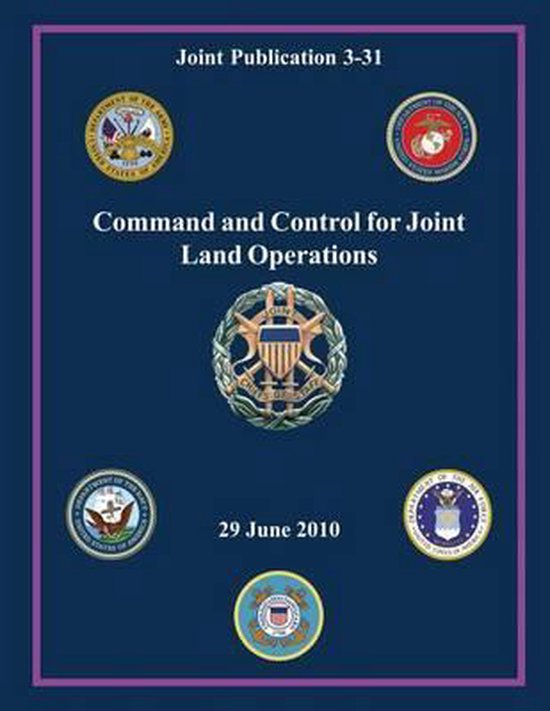Command and Control for Joint Land Operations (Joint Publication 3-31) Joint Publication 3-31
Afbeeldingen
Artikel vergelijken
Uitgever: Createspace Independent Publishing Platform
- Engels
- Paperback
- 9781480126831
- 16 oktober 2012
- 166 pagina's
Samenvatting
This publication, “Command and Control for Joint Land Operations (Joint Publication 3-310,” provides doctrine for the command and control of joint land operations by a joint force land component commander (JFLCC). It addresses considerations for forming and establishing a functional land force component with a designated JFLCC and for planning, execution, and assessment of joint force land operations across the range of military operations. It sets forth joint doctrine to govern the activities and performance of the Armed Forces of the United States in joint operations and provides the doctrinal basis for interagency coordination and for US military involvement in multinational operations. Command and control (C2) of joint land operations is fundamental to warfare. Having a land component commander (LCC) is not new to the Armed Forces of the United States. The Allies in World War II successfully employed separate joint or multinational LCC headquarters in several theaters. These land component commands ensured proper coordination with other components and freed the multinational force commander to focus on overall strategy. In the 20th century, joint and multinational operations have encompassed the full diversity of air, land, maritime, and space forces operating throughout the operational area. Advances in capabilities among all forces and the ability to communicate over great distances have made the application of military power in the 21st century more dependent on the ability of commanders to synchronize and integrate joint land operations with other component’s operations. The manner in which geographic combatant commanders (GCCs) organize their forces directly affects the C2, responsiveness, and versatility of joint force operations. Combatant commanders (CCDRs) organize assigned and attached forces to accomplish the mission based on the CCDRs’ vision and concept of operations (CONOPS) as well as considerations of mission, enemy, terrain and weather, troops and support available — time available. Unity of action, centralized planning and direction, and decentralized execution are also key considerations. CCDRs can conduct operations through subordinate unified commands, subordinate joint task forces (JTFs), single-Service task forces, Service components, functional components, or a combination of Service and functional components. Not only can the GCC designate a JFLCC, but each subordinate joint force commander (JFC) may also designate their own JFLCC. Consequently, there may be multiple LCCs, each with an organization, duties, and responsibilities tailored to the requirements of their specific JFC, within a single area of responsibility (AOR). Where multiple joint operations areas each have land operations being conducted, the JFLCC designated directly by the GCC, may also be designated the theater JFLCC. The primary responsibilities of the theater JFLCC may be to provide coordination with other theater-level functional components, to provide general support to the multiple JFLCCs within the AOR, to conduct theater-level contingency planning, or to conduct joint reception, staging, onward movement, and integration for the entire joint land force. This publication has been prepared under the direction of the Chairman of the Joint Chiefs of Staff (CJCS). It sets forth joint doctrine to govern the activities and performance of the Armed Forces of the United States in joint operations and provides the doctrinal basis for interagency coordination and for US military involvement in multinational operations. It provides military guidance for the exercise of authority by combatant commanders and other joint force commanders (JFCs) and prescribes joint doctrine for operations, education, and training. It provides military guidance for use by the Armed Forces in preparing their appropriate plans.
Productspecificaties
Wij vonden geen specificaties voor jouw zoekopdracht '{SEARCH}'.
Inhoud
- Taal
- en
- Bindwijze
- Paperback
- Oorspronkelijke releasedatum
- 16 oktober 2012
- Aantal pagina's
- 166
- Illustraties
- Nee
Betrokkenen
- Hoofdauteur
- Chairman Of The Joint Chiefs Of Staff
- Hoofduitgeverij
- Createspace Independent Publishing Platform
Overige kenmerken
- Extra groot lettertype
- Nee
- Product breedte
- 216 mm
- Product hoogte
- 9 mm
- Product lengte
- 280 mm
- Verpakking breedte
- 216 mm
- Verpakking hoogte
- 9 mm
- Verpakking lengte
- 280 mm
- Verpakkingsgewicht
- 399 g
EAN
- EAN
- 9781480126831
Je vindt dit artikel in
- Categorieën
- Taal
- Engels
- Boek, ebook of luisterboek?
- Boek
- Studieboek of algemeen
- Algemene boeken
Kies gewenste uitvoering
Bindwijze
: Paperback
Prijsinformatie en bestellen
Rapporteer dit artikel
Je wilt melding doen van illegale inhoud over dit artikel:
- Ik wil melding doen als klant
- Ik wil melding doen als autoriteit of trusted flagger
- Ik wil melding doen als partner
- Ik wil melding doen als merkhouder
Geen klant, autoriteit, trusted flagger, merkhouder of partner? Gebruik dan onderstaande link om melding te doen.

